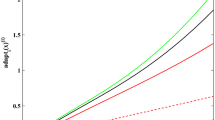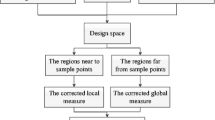Abstract
When dealing with complex reliability problems, the classical ensemble of surrogate models (CESM) has better ability of prediction and generalization than the individual surrogate model. However, since the CESM only considers the global errors of the sample set, the prediction results of the sample points far away from the region where most of the samples gather might not be so accurate, and the fitting accuracy of the limit state function will also be affected when the sample points are sparse. In view of the above situation, this paper proposes an adaptive ensemble of surrogate models based on hybrid measure (AESMHM), which comprehensively considers the global errors and local errors. The global weight matrix is modified by the local weight matrix of representative sample points to obtain the hybrid weight of each surrogate model. Through the discussion of four examples, it can be proved that AESMHM can not only improve the prediction accuracy of the whole sample points, but also have higher computational efficiency. Finally, the reliability problem of a radome structure in composite material is solved efficiently by the proposed method.
















Similar content being viewed by others
References
Acar E (2010) Various approaches for constructing an ensemble of metamodels using local measures. Struct Multidisc Optim 42(6):879–896
Acar E, Rais-Rohani M (2009) Ensemble of metamodels with optimized weight factors. Struct Multidisc Optim 37(3):279–294
Bichon BJ, Eldred MS, Swiler LP (2008) Efficient global reliability analysis for nonlinear implicit performance functions. AIAA J 46(10):2459–2468
Bourinet JM, Deheeger F, Lemaire M (2011) Assessing small failure probabilities by combined subset simulation and support vector machines. Struct Saf 33(6):343–353
Chang CC, Lin CJ (2007) LIBSVM: a library for support vector machines. ACM Trans Intell Syst Technol 2(3):1–27
Cheng K, Lu Z (2020) Structural reliability analysis based on ensemble learning of surrogate models. Struct Saf 83:101905
Cortes C, Vapnik V (1995) Support-vector networks. Mach Learn 20(3):273–297
Echard B, Gayton N, Lemaire M (2011) AK-MCS: an active learning reliability method combining kriging and monte carlo simulation. Struct Saf 33(2):145–154
Erfani SM, Rajasegarar S, Karunasekera S, Leckie C (2016) High-dimensional and large-scale anomaly detection using a linear one-class SVM with deep learning. Pattern Recognit 58:121–134
Feng K, Lu Z, Pang C, Yun W (2018) Efficient numerical algorithm of profust reliability analysis: an application to wing box structure. Aerosp Sci Technol 80:203–211
Goel T, Haftka RT, Wei S, Queipo NV (2007) Ensemble of surrogates. Struct Multidisc Optim 33(3):199–216
Gunst RF, Myers RH, Montgomery DC (1996) Response surface methodology: process and product optimization using designed experiments. Technometrics 38(3):285
Gutmann HM (2001) A radial basis function method for global optimization. J Glob Optim 19(3):201–227
Hardy RL (1971) Multiquadric equations of topography and other irregular surfaces. J Geophys Res 76(8):1905–1915
Hasofer AM, Lind NC (1974) Exact and invariant second moment code format. J Eng Mech 100(1):111–121
Helton JC, Davis FJ (2002) Sampling-based methods for uncertainty and sensitivity analysis. Risk Anal 22(3):591–622
Hu C, Youn BD, Yoon H (2012) An adaptive dimension decomposition and reselection method for reliability analysis. Struct Multidisc Optim 47(3):423–440
Huntington DE, Lyrintzis CS (1998) Improvements to and limitations of latin hypercube sampling. Probab Eng Mech 13(4):245–253
Hurtado JE, Alverez DA (2001) Neural-network-based reliability analysis: a comparative study. Comput Methods Appl Mech Eng 191(1/2):113–132
James KE, White RF, Kraemer HC (2010) Repeated split sample validation to assess logistic regression and recursive partitioning: an application to the prediction of cognitive impairment. Stat Med 24(19):3019–3035
** R, Simpson TW (2001) Comparative studies of metamodeling techniques under multiple modeling criteria. Struct Multidisc Optim 23(1):1–13
Jones DR, Schonlau M, Welch WJ (1998) Efficient global optimization of expensive black-box functions. J Glob Optim 13(4):455–492
Kaw A (2005) Mechanics of composite materials. CRC Press, Boca Raton
Kiureghian AD (2000) The geometry of radom vibrations and solutions by FORM and SORM. Probab Eng Mech 15(1):81–90
Krige DG (1952) A statistical analysis of some borehole values in the orange free state goldfield. J Chem Metall Soc S Afr 53:47–64
Lee Y, Choi DH (2014) Pointwise ensemble of meta-models using v nearest points cross-validation. Struct Multidisc Optim 50(3):383–394
Liu Y, Li L (2020) Global reliability sensitivity analysis based on state dependent parameter method and efficient sampling techniques. Aerosp Sci Technol 99:105740
Liu PF, Zheng JY (2010) Recent developments on damage modeling and finite element analysis for composite laminates: a review. Mater Des 31(8):3825–3834
Lophaven SN, Nielsen HB, Sndergaard J (2002) DACE—a MATLAB kriging toolbox. Technical report IMM-TR-2002-12, Technical University of Denmark
Ma J, Theiler J, Perkins S (2003) Accurate on-line support vector regression. Neural Comput 15(11):2683–2703
Matheron G (1963) Principles of geostatistics. Econ Geol 58(8):1246–1266
Mertens S, Engel A (1997) Vapnik-chervonenkis dimension of neural networks with binary weights. Phys Rev E 55(4):4478–4488
Nogal M, Martinez-Pastor B, Rui T, O’Connor A (2020) Reliability analysis using a multi-metamodel complement-basis approach. Reliab Eng Syst Saf 205(19–20):107248
Rackwitz R (2001) Reliability analysis—a review and some perspectives. Struct Saf 23(4):365–395
Rui T, Nogal M, O’Connor A (2020) Adaptive approaches in metamodel-based reliability analysis: a review. Struct Saf 89:102019
Sacks J, Welch WJ, Wynn MHP (1989) [Design and analysis of computer experiments]: rejoinder. Stat Sci 4(4):433–435
Schu Ee Ller GI, Pradlwarter HJ, Koutsourelakis PS (2004) A critical appraisal of reliability estimation procedures for high dimensions. Probab Eng Mech 19(4):463–474
Sciuva M, Lomario D (2003) A comparison between Monte Carlo and FORMs in calculating the reliability of a composite structure. Compos Struct 59(1):155–162
Shen GL, Hu GK, Lin B (2013) Mechanics of composite materials. Tsinghua University Press, Bei**g
Spottswood SM, Palazotto AN (2001) Progressive failure analysis of a composite shell. Compos Struct 53(1):117–131
Sundar VS, Shields MD (2016) Surrogate-enhanced stochastic search algorithms to identify implicitly defined functions for reliability analysis. Struct Saf 62:1–11
Tarantola S, Becker W, Zeitz D (2012) A comparison of two sampling methods for global sensitivity analysis. Comput Phys Commun 183(5):1061–1072
Trafalis TB, Gilbert RC (2006) Robust classification and regression using support vector machines. Eur J Oper Res 173(3):893–909
Viana FA, Haftka RT, Steffen V Jr (2009) Multiple surrogates: how cross-validation errors can help us to obtain the best predictor. Struct Multidisc Optim 39(4):439–457
Viana F, Haftka RT, Watson LT (2013) Efficient global optimization algorithm assisted by multiple surrogate techniques. J Glob Optim 56(2):669–689
Wen Z, Pei H, Liu H, Yue Z (2016) A Sequential Kriging reliability analysis method with characteristics of adaptive sampling regions and parallelizability. Reliab Eng Syst Saf 153:170–179
Wilson G (1951) On the experimental attainment of optimum conditions. J R Stat Soc Ser B 13(1):1–45
Zhang J, Yue X, Qiu J, Zhang M, Wang X (2020) A unified ensemble of surrogates with global and local measures for global metamodelling. Eng Optim 1:1–22
Zhang X, Lu Z, Cheng K (2021) AK-DS: an adaptive kriging-based directional sampling method for reliability analysis. Mech Syst Signal Process 156(15):107610
Zhao D, Xue DY (2011) A multi-surrogate approximation method for metamodeling. Eng Comput 27(2):139–153
Zhen H, Mahadevan S (2015) Global sensitivity analysis-enhanced surrogate (GSAS) modeling for reliability analysis. Struct Multidisc Optim 53(3):1–21
Zhou CC, Lu ZZ, Zhang F, Yue ZF (2015) An adaptive reliability method combining relevance vector machine and importance sampling. Struct Multidisc Optim 52(5):945–957
Zhou CC, Li C, Zhang HL, Zhao HD, Zhou CP (2021) Reliability and sensitivity analysis of composite structures by an adaptive Kriging based approach. Compos Struct 278:114682
Acknowledgements
This work is supported by the National Natural Science Foundation of China (Grant No. NSFC51975476), and the Natural Science Basic Research Program in Shaanxi (Grant No. 2020JM-135).
Author information
Authors and Affiliations
Corresponding author
Ethics declarations
Conflict of interest
The authors declare that they have no conflict of interest.
Replication of results
Code and data for replication can be provided upon request.
Additional information
Responsible Editor: Palaniappan Ramu
Publisher's Note
Springer Nature remains neutral with regard to jurisdictional claims in published maps and institutional affiliations.
Rights and permissions
About this article
Cite this article
Zhou, C., Zhang, H., Chang, Q. et al. An adaptive ensemble of surrogate models based on hybrid measure for reliability analysis. Struct Multidisc Optim 65, 16 (2022). https://doi.org/10.1007/s00158-021-03129-1
Received:
Revised:
Accepted:
Published:
DOI: https://doi.org/10.1007/s00158-021-03129-1




